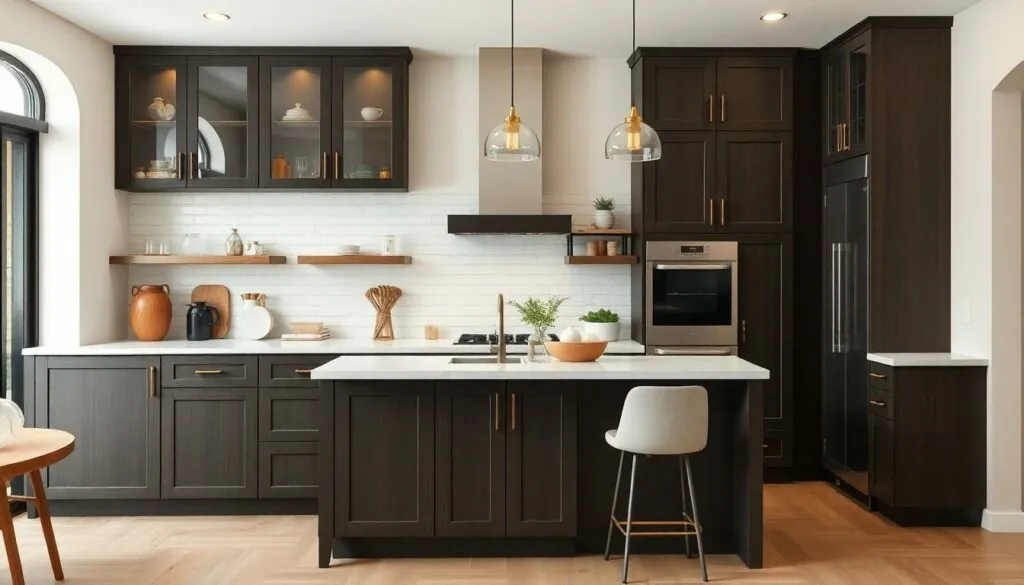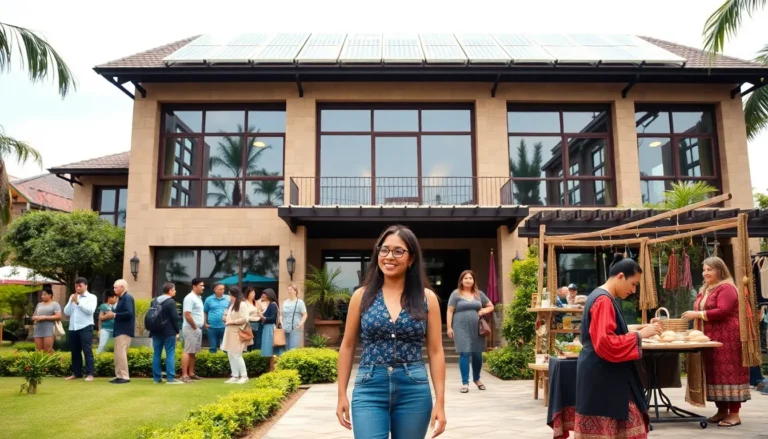Table of Contents
ToggleWhen it comes to kitchen design, dark cabinets can feel like a bold statement—like wearing a black tuxedo to a barbecue. But fear not! With the right espresso color schemes, those cabinets can transform from intimidating to inviting faster than you can say “espresso martini.”
Understanding Espresso Color Schemes
Espresso color schemes enhance the appeal of kitchens featuring dark cabinets. These schemes focus on rich, deep tones that create a cohesive and inviting atmosphere.
Definition of Espresso Color Schemes
Espresso color schemes incorporate shades of dark brown resembling coffee. This color palette includes colors like charcoal, cream, and soft taupe. By using these hues, designers achieve a sophisticated balance that complements dark cabinets. They often evoke warmth and elegance, inviting a cozy ambiance.
Significance in Kitchen Design
Integrating espresso color schemes significantly impacts kitchen aesthetics. A well-chosen color palette can elevate dark cabinets, making the space feel cohesive. Light accents contrast beautifully against darker tones, preventing the kitchen from appearing too heavy. Additionally, these schemes enhance natural light sources, creating brightness and warmth. Customized espresso palettes foster unique kitchen environments ideal for gathering and cooking.
Popular Espresso Color Combinations

Rich espresso cabinets pair beautifully with carefully selected color combinations. These colors create harmony and balance in the kitchen, transforming it into a welcoming space.
Contrasting Colors for Balance
Contrasting colors offer a striking balance against dark espresso. White provides a crisp, bright contrast that emphasizes depth. Light gray also complements dark cabinets, creating a sophisticated, neutral appearance. Soft beige introduces warmth, establishing a cozy feel. Incorporating vibrant hues like teal or mustard can infuse energy into the kitchen while highlighting espresso’s richness. Each of these colors accentuates the espresso tones, ensuring the kitchen design remains inviting yet dynamic.
Accent Colors to Enhance Espresso Cabinets
Accent colors add depth and dimension to espresso cabinets. Gold or brass embellishments bring a hint of luxury to the overall design. Deep red or burgundy enriches the palette; these shades evoke warmth and sophistication. Earthy greens, such as sage or olive, create a refreshing contrast, bringing a bit of nature indoors. Incorporating these accents through kitchen accessories or decor enhances the visual appeal of dark cabinets, creating a cohesive and engaging space for cooking and entertaining.
How to Choose the Right Color Scheme
Choosing the right color scheme requires careful consideration of various elements. Focus on how colors interact with dark cabinets to create the desired atmosphere.
Considerations for Light and Space
Natural light impacts how colors appear in the kitchen. Dark cabinets absorb more light, making the room feel smaller. Using lighter shades helps to create a sense of openness and balance. Soft tones like cream and light gray make a striking contrast, lifting the overall aesthetic. Incorporating mirrors or reflective surfaces enhances light distribution, further brightening the space. Planning color placements strategically can guide the eye and enhance flow within the kitchen.
The Role of Lighting in Color Perception
Lighting significantly influences color perception in a kitchen. Fluorescent bulbs can alter the appearance of espresso tones, making them appear dull or cold. Warm light fixtures, such as LED or incandescent bulbs, amplify the richness of dark cabinets, creating an inviting ambiance. Varying light sources, including under-cabinet lighting, contribute to layered illumination, enhancing color depth. Assessing different lighting options in various times of the day helps identify the most complementary color choices. Emphasizing the right lighting type ensures the color scheme feels cohesive and harmonious.
Trends in Kitchen Design
Dark cabinets continue to dominate kitchen design, offering a bold choice that creates a striking focal point. Designers increasingly embrace rich espresso color schemes, which balance elegance and warmth in contemporary spaces.
Current Trends with Dark Cabinets
Popularity of dark cabinets remains strong, especially in modern kitchens. Trendy materials, such as matte finishes or textured woods, enhance the appeal of these cabinets. Many homeowners prefer darker hues for their sleek and sophisticated look, which contrasts beautifully with lighter countertops and backsplashes. Integration of open shelving alongside dark cabinets introduces visual interest and creates an inviting atmosphere. Additionally, eco-friendly materials in cabinetry gain traction, aligning design aesthetics with sustainability values.
Influence of Espresso on Modern Aesthetics
Espresso tones bring a sense of depth to kitchen aesthetics, complementing various styles from traditional to minimalist. Incorporation of espresso cabinets creates a backdrop that amplifies the beauty of any decorative elements. While dark espresso enhances overall warmth, pairing it with pale colors yields a visually pleasing contrast. Touches of brass or gold complement espresso beautifully, adding a luxurious feel. As a result, this rich color scheme ensures kitchens look both modern and timeless, appealing to diverse tastes and preferences.
Tips for Implementing Espresso Color Schemes
Incorporating espresso color schemes into kitchen designs enhances the appeal of dark cabinets, fostering a warm and inviting atmosphere. Following key tips ensures successful implementation of these rich, deep tones.
Best Practices for Color Application
Choose versatile colors that harmonize with the espresso base, such as creams, soft taupes, and light grays. Use contrasting accents, like vibrant hues and earthy greens, to create visual intrigue. Limit the number of accent colors to maintain cohesion in the overall design. Apply lighter shades to walls and larger surfaces to counterbalance dark cabinets, helping the space feel open. Utilize reflective surfaces to amplify natural light, enhancing the richness of espresso tones. Integrate varied light sources to create a layered illumination effect, which adds depth to the color scheme.
Mistakes to Avoid When Choosing Colors
Overloading the space with too many colors can overwhelm the design, leading to visual chaos. Ignoring the impact of natural light on color perception often results in a poorly lit kitchen. Underestimating the importance of contrast can make dark cabinets feel heavy. Choosing colors that clash with espresso can disrupt the intended cozy atmosphere. Failing to consider the size of the kitchen may contribute to an enclosing feeling. Skipping the examination of materials might result in inconsistent textures, compromising the overall aesthetic value.
Espresso color schemes offer a transformative approach to kitchens with dark cabinets. By thoughtfully integrating rich tones and contrasting accents homeowners can create a warm and inviting atmosphere. The right blend of colors not only enhances the visual appeal of dark cabinets but also fosters a cozy environment ideal for cooking and entertaining.
Incorporating lighter shades and reflective surfaces can counterbalance the depth of espresso tones while ensuring the space feels open and welcoming. With current trends leaning towards sustainable materials and elegant finishes the potential for creativity in kitchen design is limitless. Embracing these color schemes allows for a unique expression of style that resonates with both modern and traditional aesthetics.



